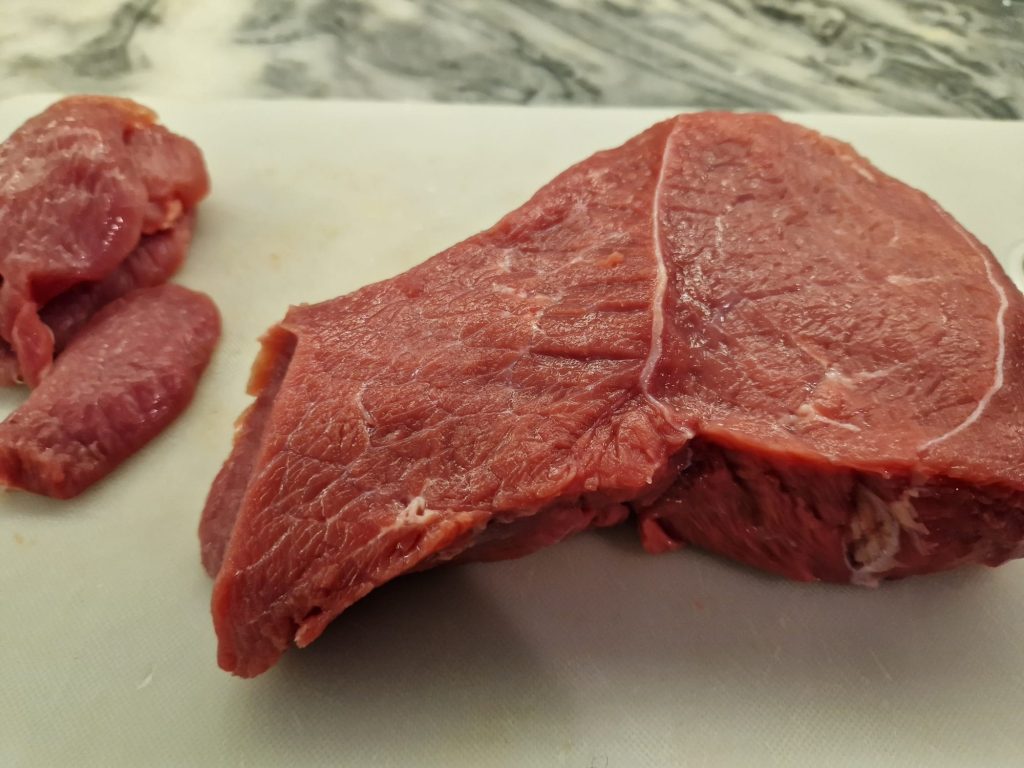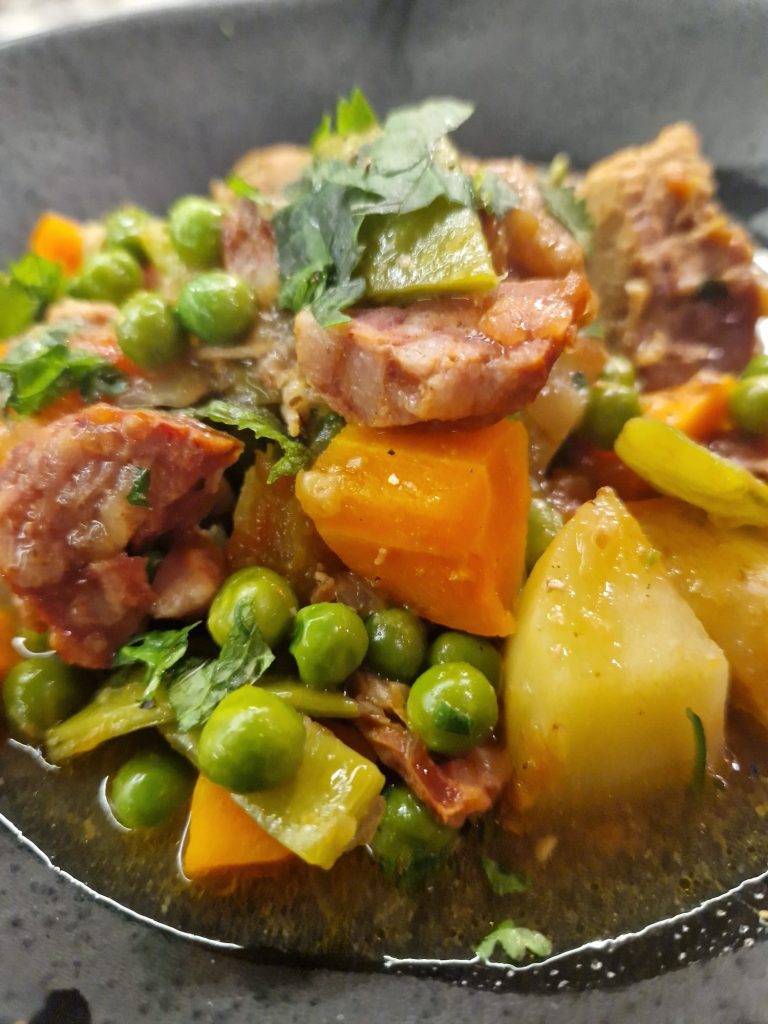
As the skies darken and winter beckons in Lisbon, it’s time for a good stew. A Portuguese home classic – jardineira.
Jardineira means gardener. Sounds like a salad, but it isn’t. The name comes from the dish using whatever vegetables are in season in the garden at the time. Indisputably countryside.
It’s not something you’ll typically find out at restaurants. Maybe scribbled on a menu do dia, in some neighbourhood tasca, in the colder months.
It is a dish, however, that I’ve seen Portuguese folks talk about with literal love hearts in their eyes. A family staple, a conduit of childhood memories. The padrão of Portuguese beef stews.
It reminds me a bit of a classic French beef stew, but it’s less rich, more green. Tender cuts of cubed beef, carrots, potatoes, tomatoes, and, for me, the defining ingredient that really gives this dish the ‘gardener’ look – peas. Slowly simmered in a hearty broth of cheap wine, garden herbs and pantry aromatics.
Jardineira is veal
Jardiniera is usually done with vitela – calf, or veal. This is beef from younger cattle, less coarse, more tender. In this dish, it’s cubed – about 700 grams of it. I got a chunk from the butchers, trimmed the fat, and diced it into 3cm cubes, against the grain.

A lot of jardineira recipes call for giving the meat its initial burn on a bed of sautéed onions and garlic. I prefer doing it the other way around: a good sear first, then in with the aromatics.
It’s not a bad idea to dust the beef cubes with about 1.5tbsp flour before they hit the pan. This helps them to brown nicely in the initial stages of cooking, but also to thicken the sauce later.
The first part of cooking is to give the beef a nice sear. If your pan is too small, do it in batches. Don’t overcrowd the pan, and keep the heat at medium-high. The pan needs to be hot, but not steak hot. If it burns a little, that’s fine: the white wine, as well as water released from the onion, will deglaze the pan later on, and you’ll easily be able to easily scrape off any fond from the bottom.
Vegetables, more vegetables
The usual cast of vegetables here is peas, carrots and potatoes. Tomato, either fresh or canned. Plus onions, garlic, and whatever herbs you have to hand. For me, it was thyme, mint and coriander.
The vegetables are added later, and according to their cooking time. This allows them to cook through while staying tender-crisp.

This version has some very slight additions around the edges compared to the most basic of recipes. Nothing too fancy, though. Green beans is a seasonal addition, although not uncommon. Sliced along the edges for faster cooking while staying crisp. The tomatoes are peeled and deseeded, to concentrate the flavour. There’s also fresh mint as a finishing touch, which cuts nicely through the richness of the broth.
A slow cook stew
You can make the whole thing in about 2 hours. It might take you longer to get the beef really tender, or it might happen faster. However long it ends up taking you, try and keep some jardineira aside for tomorrow. It’s a simple fact that stews taste better the day after. So if you can make this a day in advance, do so.

Personally, I can never resist. But you might be able to. So if you can, exercise that power. Your tastebuds will thank you.
Do as you please, though. Either way, this is Portuguese comfort food per excellence.

Gardener’s Beef Stew (Jardineira)
Ingredients
- 3 tbsp olive oil
- 1.5 tbsp flour
- 700 g veal or beef, cut into 3cm cubes
- 1 sausage chouriço or linguiça, chopped into half-moons
- 100 g bacon sliced into thin pieces
- 1 onion diced
- 3 cloves garlic diced
- 1 tbsp tomato paste
- 3 ripe tomatoes peeled, deseeded, halved and quartered (or 400g good quality tinned tomatoes)
- 150 ml white wine
- 750 ml meat stock or vegetable
- 1 bay leaf
- 3 sprigs thyme leaves removed
- 4 medium potatoes peeled and cut into quarters
- 2 carrots peeled and chopped into half moons
- 6 pods green beans ends removed, sliced along the edges, and chopped into 3cm pieces
- 150 g peas either frozen or canned and drained
- 1 bunch coriander freshly chopped
- 1 bunch mint freshly chopped
- sea salt to taste
- freshly ground black pepper to taste
- 1 drop Portuguese piri-piri oil (or 1tbsp chili flakes) optional
Instructions
- Chop the beef into cubes, trim off any excess fat, and dust with about 1.5tbsp of flour.
- Finely dice the onions and garlic, and slice the chouriço and bacon into thin pieces. Peel the tomatoes (you can do this by submerging the tomatoes in hot water for about 30 seconds, then running them under a cold tap, after which the skin should slide off), chop them in half, deseed them, and then chop the halves into quarters, so that you have 8 slices per tomato.
- Add the olive oil to a large saucepan or dutch oven that you can cover later, and set the heat to medium-high. Once the pan is hot, add the beef cubes, seasoning with salt and pepper when they hit the pan. Do this in batches, if you need to, so as to get a nice crust and not overcrowd the pan.
- Sear for around 3-4 minutes, and then flip to the opposite side, and sear for another 3-4 minutes. You should have a nice browning, with some good sear marks.
- Once the beef has a nice crust, remove it from the pan and set aside for later. Add the onions, chouriço, bacon and bay leaf to the same pan, and sauté for around 3 minutes, stirring gently. If there are brown marks on the bottom of the pan from the beef, don't worry.
- Next add the garlic, and sauté for a further minute.
- Add the tomato paste, and fry it down for about another minute, or until the colour darkens. This deepens the flavour of the dish.
- Add the chopped tomatoes, or the canned tomatoes if you’re using them, with a pinch of salt. Cook down for another two to three minutes.
- Next, turn the heat to high, add a glug of white wine (about 150ml) and reduce until just over half of the wine has evaporated.
- Return the beef cubes to the pot, mix well to coat, and add your stock until it just covers the beef. Season with salt and pepper, add the thyme sprig, turn the heat to very low, and cover the pan with a lid (covering the pan allows enough liquid to retain for cooking the vegetables later). Leave, on a low simmer, for around 1 hour, stirring every 15 minutes or so.
- After 1 hour, uncover the pot so that the lid is half on, half off. This is to help start thickening the broth. Check regularly for seasoning, and if you want a bit of spice, add a drop or two of Portuguese piri-piri oil, or some chili flakes. Cook for another 30 minutes on a very low simmer, during which time you can peel and chop the carrots and potatoes, and top, tail and slice the green beans.
- After 30 minutes (or when you feel the beef is very tender and a sideways fork easily cuts through it), remove the bay leaf, and add the potatoes, carrots and green beans, ensuring there is enough liquid left in the pan so that it doesn’t dry out. If so, add more stock.
- After 12-15 minutes, or when the potatoes are slightly tender when prodded with a fork, add the peas.
- Simmer for 5 minutes more, taste for seasoning, and sprinkle mint and coriander around the pot.
- Plate your jardineira, serve with more freshly chopped mint and coriander, and enjoy.

Leave a Reply